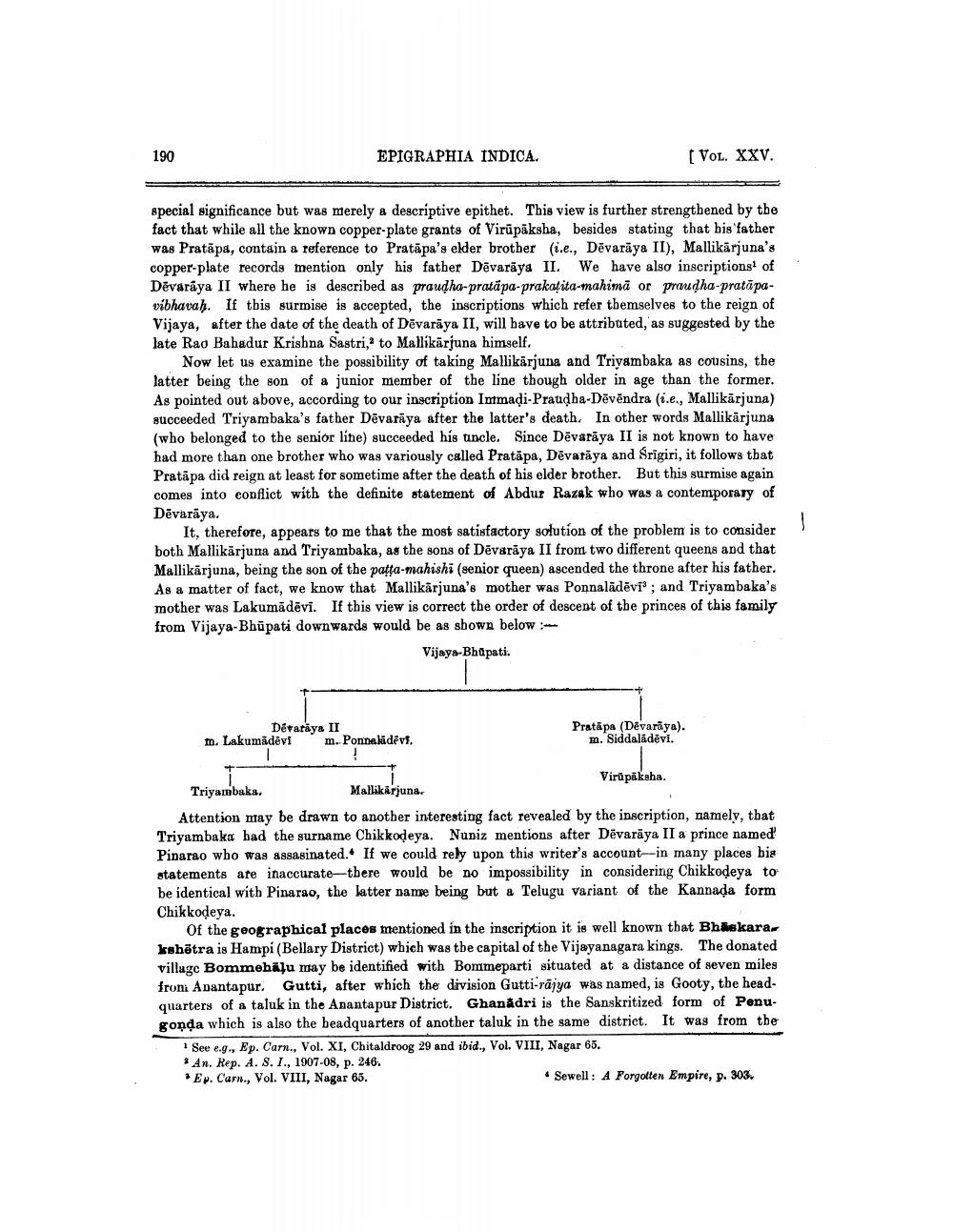________________
190
EPIGRAPHIA INDICA.
(VOL. XXV.
special significance but was merely a descriptive epithet. This view is further strengthened by the fact that while all the known copper-plate grants of Virūpäksha, besides stating that his father was Pratápa, contain a reference to Pratapa's elder brother (i.e., Devaraya II), Mallikarjuna's copper-plate records mention only his father Dēvarāya II. We have also inscriptions of Devaraya II where he is described as praudha-pratāpa-prakaita-mahimā or proudha-pratāpavibhavah. If this surmise is accepted, the inscriptions which refer themselves to the reign of Vijaya, after the date of the death of Dēvarāya II, will have to be attributed, as suggested by the late Rao Bahadur Krishna Sastri,' to Mallikarjuna himself.
Now let us examine the possibility of taking Mallikarjuna and Triyambaka as cousins, the latter being the son of a junior member of the line though older in age than the former. As pointed out above, according to our inscription Inmadi-Praudha-Dēvēndra (i.e., Mallikarjuna) succeeded Triyambaka's father Dēvariya after the latter's death. In other words Mallikarjuna (who belonged to the senior line) succeeded his tincle. Since Dēvarāya II is not known to have had more than one brother who was variously called Pratāpa, Dēvatāya and Srigiri, it follows that Pratäpa did reign at least for sometime after the death of his elder brother. But this surmise again comes into conflict with the definite statement of Abdur Razak who was a contemporary of Dēvarāya.
It, therefore, appears to me that the most satisfactory solution of the problem is to consider both Mallikarjuna and Triyambaka, as the sons of Dēvarāya II from two different queens and that Mallikarjuna, being the son of the patta-mahishi (senior queen) ascended the throne after his father. As a matter of fact, we know that Mallikarjuna's mother was Ponnalādēvi'; and Triyambaka's mother was Lakumādēvi. If this view is correct the order of descent of the princes of this family from Vijaya-Bhūpati downwards would be as shown below:
Vijaya-Bhüpati.
Détataya II m. Lakumādévim . Ponnekādēvs.
Pratápa (Dēvariya).
m. Siddalādēvi.
Virupaksha. Triyambaka.
Mallikarjuna. Attention may be drawn to another interesting fact revealed by the inscription, namely, that Triyambaka bad the surname Chikkodeya. Nuniz mentions after Dēvarāya II a prince named Pinarao who was assasinated. If we could rely upon this writer's account-in many places bis statements ate inaccurate-there would be no impossibility in considering Chikkodeya to be identical with Pinarao, the latter name being but a Telugu variant of the Kannada form Chikkodeya.
Of the geographical places mentioned in the inscription it is well known that Bhaskara. kshötra is Hampi (Bellary District) which was the capital of the Vijayanagara kings. The donated village Bommehāļu may be identified with Bommeparti situated at a distance of seven miles from Anantapur. Gutti, after which the division Gutti-rajya was named, is Gooty, the headquarters of a taluk in the Anantapur District. Ghanädri is the Sanskritized form of Penu. gonda which is also the beadquarters of another taluk in the same district. It was from the
Seu e..., Ep. Carn., Vol. XI, Chitaldroog 29 and ibid., Vol. VIII, Nagar 65. * An. Rep. A. 8.I., 1907-08, p. 246. * Ep. Carn., Vol. VIII, Nagar 65.
• Sewell: A Forgotten Empire, p. 303.




